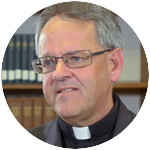
Father Thomas Dailey, O.S.F.S.
Having received my first correspondence from the Social Security Administration, I must officially be old! Perhaps, then, I can speak with some insight, if not also wisdom gained from age, about “the next generation.”
If there is one, that is — at least in terms of church-goers.
The numbers are staggering. In a diocese I recently visited, the local bishop informed his flock about “a significant decline in Catholic affiliation and participation.” Since 2000, parish registrations there have declined 36 percent, Mass attendance dropped by 60 percent and sacraments received were down by about 65 percent. Add to that a 43 percent decrease in the number of priests in active ministry, with a projected loss of another 20 percent by 2025, and the prospects look grim.
[hotblock]
That’s just one diocese, in one part of the country, where the overall population is also decreasing. But similar numbers drive the story elsewhere, too.
If 40 years constitute a generation, these numbers reflect just the first half of our future. Given the trajectory, what do the next 20 years portend? Will there even be a local church when the younger generation comes of age?
Doomsday scenarios contrast sharply with our faith. We believe, as Jesus says, that the church will remain “rock” solid in terms of its continuing presence in our world (Matt 16:18). Some think that tomorrow’s church will actually grow by becoming smaller; the so-called “Benedict Option” advocates for a faithful remnant “to embrace exile from mainstream culture and construct a resilient counterculture.”
But a smaller and stronger church still needs people in it. Given today’s trends, the actuarial forecast demands our attention.
Some will undoubtedly object that growth in the church is not about numbers, but about faithfulness. True. But, as accountants like to say, “no margin, no mission.” Beyond the financial concerns, the church’s mission to proclaim the Good News of salvation will be adversely impacted if its adherents continue to vanish. It is about the numbers when we remember these represent souls in need of salvation.
We celebrate that salvation at Mass and through the sacraments. But with fewer young people present in church on a regular basis, how will the next generation know what’s going on there?
[tower]
Unfortunately, the most recent apostolic exhortation by Pope Francis – Christus Vivit – does not directly address the active participation of young people in the liturgical life of the church. Opening with the affirmation that “Christ is alive and he wants you to be alive,” the pope crafts his message “to young people and to the entire people of God” in a way that looms much larger than worship.
In his analysis of the text, Jesuit Father Antonio Spadaro notes the recurrence of terminology associated with “living” and with “youth” (exactly 280 times each) and claims that “the pivot around which the entire discourse rotates” is “a life fully lived.”
But the exhortation does intend “to remind you [young people] of certain convictions born of our faith, and at the same time to encourage you to grow in holiness and in commitment to your personal vocation” (no. 3). In that case, one might legitimately ask what role the Sunday celebration plays in their conviction, growth and commitment.
Given the document’s length (32,632 words in 299 paragraphs, plus 164 endnotes), a comparable analysis of terminology puts that question into bold relief.
The exhortation refers to the “Eucharist” just five times: as a source of strength (no. 35) and growth (no. 173), through the nourishing presence of Christ (no. 229), whom youth are invited to receive (no. 161) and to adore (no. 299).
But mention of the “Mass” is nowhere found in the text; it appears only in the notes (in four titles of homilies cited). And “liturgy” figures only twice in the document, both times referring to areas of youth ministry needing to be developed.
These word counts should not detract from the otherwise praiseworthy aspects of the newest papal exhortation. On the whole, it does provide what Archbishop Chaput calls “a wonderful summons to the church to more vigorously invest in youth and young adults.”
But for the sake of our ecclesial future, that effort must eventually lead the next generation back to the pews, where they can uniquely experience the transcendent power and sacramental presence of Christ. After all, as a previous synod noted, the Eucharist is the source and summit of the Christian life.
Without a summons to Sunday, our investment in young adults will not yield long-term dividends for the church, locally or universally.
***
Father Dailey is the John Cardinal Foley Chair of Homiletics and Social Communications at St. Charles Borromeo Seminary, Wynnewood, and a research fellow for the Catholic Leadership Institute in Wayne.
PREVIOUS: Five ways poetry can increase your faith
NEXT: Unpleasant, with a purpose: How the cross evangelizes the culture



Share this story